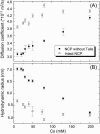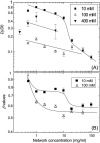Transport of nucleosome core particles in semidilute DNA solutions
- PMID: 12944295
- PMCID: PMC1303354
- DOI: 10.1016/S0006-3495(03)74610-4
Transport of nucleosome core particles in semidilute DNA solutions
Abstract
We studied the diffusion of native and trypsinized nucleosome core particles (NCPs), in aqueous solution and in concentrated DNA solutions (0.25-100 mg/ml) using fluorescence correlation spectroscopy (FCS). The highest DNA concentrations studied mimic the DNA density inside the cell nucleus. The diffusion coefficient of freely diffusing NCPs depends on the presence or absence of histone tails and is affected by the salt concentration due to the relaxation effect of counterions. NCPs placed in a network of long DNA molecules (30-50 kbp) reveal anomalous diffusion. We demonstrate that NCPs diffusion is in agreement with known particle transport in entangled macromolecular solutions as long as the histone tails are folded onto the particles. In contrast, when these tails are unfolded, the reversible adsorption of NCPs onto the DNA network has to be taken into account. This is confirmed by the fact that removal of the tails leads to reduction of the interaction between NCPs and the DNA network. The findings suggest that histone tail bridging plays an important role in chromatin dynamics.
Figures






Similar articles
-
Computer modeling reveals that modifications of the histone tail charges define salt-dependent interaction of the nucleosome core particles.Biophys J. 2009 Mar 18;96(6):2082-94. doi: 10.1016/j.bpj.2008.10.073. Biophys J. 2009. PMID: 19289035 Free PMC article.
-
Probing the effects of DNA-protein interactions on DNA hole transport: the N-terminal histone tails modulate the distribution of oxidative damage and chemical lesions in the nucleosome core particle.Biochemistry. 2012 Apr 10;51(14):3129-42. doi: 10.1021/bi201734c. Epub 2012 Mar 28. Biochemistry. 2012. PMID: 22409399
-
H2A and H2B tails are essential to properly reconstitute nucleosome core particles.Eur Biophys J. 2007 Nov;36(8):1083-94. doi: 10.1007/s00249-007-0212-9. Epub 2007 Sep 19. Eur Biophys J. 2007. PMID: 17882413
-
Cation-induced polyelectrolyte-polyelectrolyte attraction in solutions of DNA and nucleosome core particles.Adv Colloid Interface Sci. 2010 Jul 12;158(1-2):32-47. doi: 10.1016/j.cis.2009.08.002. Epub 2009 Aug 26. Adv Colloid Interface Sci. 2010. PMID: 19758583 Review.
-
Biophysics of Chromatin Dynamics.Annu Rev Biophys. 2019 May 6;48:321-345. doi: 10.1146/annurev-biophys-070317-032847. Epub 2019 Mar 18. Annu Rev Biophys. 2019. PMID: 30883217 Review.
Cited by
-
Regulation of a viral proteinase by a peptide and DNA in one-dimensional space: II. adenovirus proteinase is activated in an unusual one-dimensional biochemical reaction.J Biol Chem. 2013 Jan 18;288(3):2068-80. doi: 10.1074/jbc.M112.407312. Epub 2012 Oct 7. J Biol Chem. 2013. PMID: 23043137 Free PMC article.
-
EGFP-tagged core and linker histones diffuse via distinct mechanisms within living cells.Biophys J. 2006 Sep 15;91(6):2326-36. doi: 10.1529/biophysj.105.079343. Epub 2006 Jun 30. Biophys J. 2006. PMID: 16815908 Free PMC article.
-
Diffusion controls local versus dispersed inheritance of histones during replication and shapes epigenomic architecture.PLoS Comput Biol. 2023 Dec 18;19(12):e1011725. doi: 10.1371/journal.pcbi.1011725. eCollection 2023 Dec. PLoS Comput Biol. 2023. PMID: 38109423 Free PMC article.
-
Molecular sled is an eleven-amino acid vehicle facilitating biochemical interactions via sliding components along DNA.Nat Commun. 2016 Feb 2;7:10202. doi: 10.1038/ncomms10202. Nat Commun. 2016. PMID: 26831565 Free PMC article.
-
Regulation of a viral proteinase by a peptide and DNA in one-dimensional space: IV. viral proteinase slides along DNA to locate and process its substrates.J Biol Chem. 2013 Jan 18;288(3):2092-102. doi: 10.1074/jbc.M112.407460. Epub 2012 Oct 7. J Biol Chem. 2013. PMID: 23043138 Free PMC article.
References
-
- Ajdari, A. 1995. Transport by active filaments. Europhys. Lett. 31:69–74.
-
- Ausio, J., and K. V. Van Holdes. 1989. Use of selectively trypsinized nucleosome core particles to analyse the role of histone tails in the stabilisation of the nucleosome. J. Mol. Biol. 206:451–463. - PubMed
-
- Busch, N. A., T. Kim, and V. A. Bloomfield. 2000. Tracer diffusion of proteins in DNA solutions. 2 Green fluorescent protein in crowded solutions. Macromolecules. 33:5932–5937.
-
- Elson, E., and D. Madge. 1974. Fluorescence correlation spectroscopy- I. Conceptual basis and theory. Biopolymers. 13:1–27. - PubMed
Publication types
MeSH terms
Substances
LinkOut - more resources
Full Text Sources
Other Literature Sources

